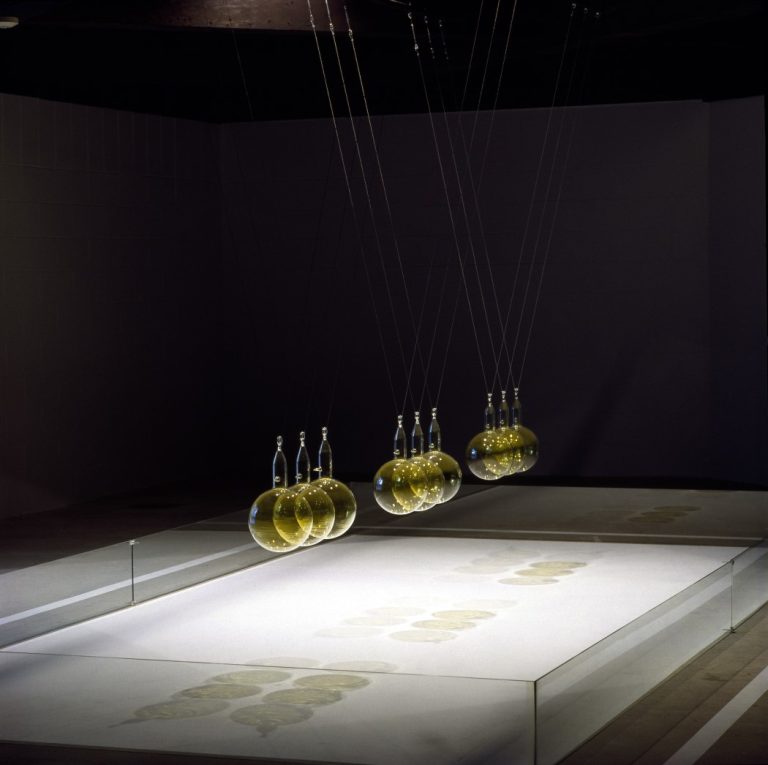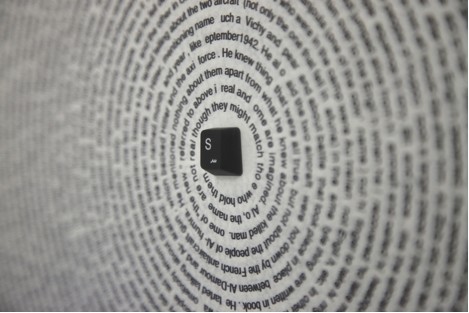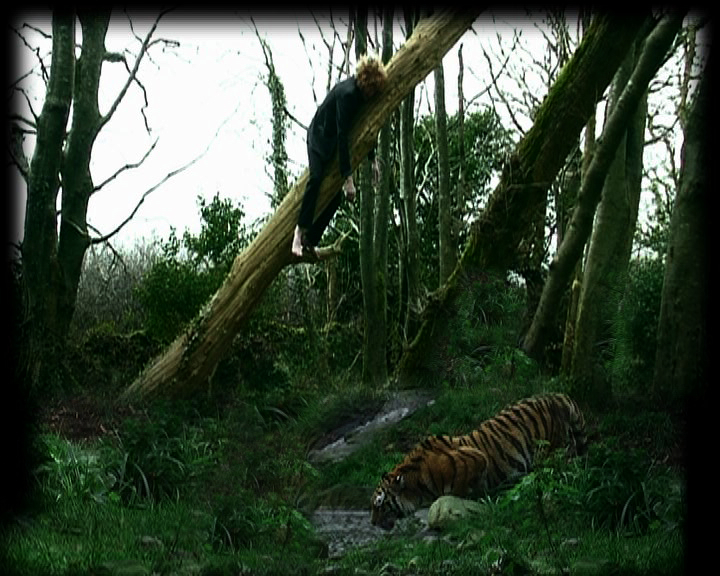There is a navel at the centre of Reflex Blue, a portal between inner and outer worlds. You can’t see it, but you can feel it when watching Elisa Giardina Papa’s ‘U Scantu’: A Disorderly Tale (2022). A repeated image in the film is a long braid of dark hair being pushed through a hole in an ornately papered wall, before coming to lie flat against it. The image is umbilical, intestinal. The word ‘visceral’ has become so commonly used as to lose a little of its potency, but you can feel your viscera contracting as you watch this glossy braid bulge through the small opening.
The navel gives the lie to the idea that our bodies are bounded and discrete. It’s the mark of connection, of dependence, a reminder of our porousness. That to come into being, we had to be tethered to another living body, to share its blood and oxygen. The idea of bodily porosity and how it relates to political attitudes was explored by sociologist Mary Douglas in her 1966 work Purity and Danger.
We should expect the orifices of the body to symbolise its specially vulnerable points. […] The mistake is to treat bodily margins in isolation from all other margins. There is no reason to assume any primacy for the individual’s attitude to his own bodily and emotional experience, any more than for his cultural and social experience.1
In ‘U Scantu’, the porous body and the marginalised outsider are placed in relationship. The work is based on orally transmitted mythologies about the donni di fora, ‘women from the outside, and beside themselves’ – symbolic figures in Sicilian folklore who were both masculine and feminine, animal and human, benevolent and malicious. The designation of these women as ‘outside’ refers to the fact that they came from the fairy realm, beyond the world of humans. They rode on goats and visited houses at night, sometimes adorning newborns with small braids.
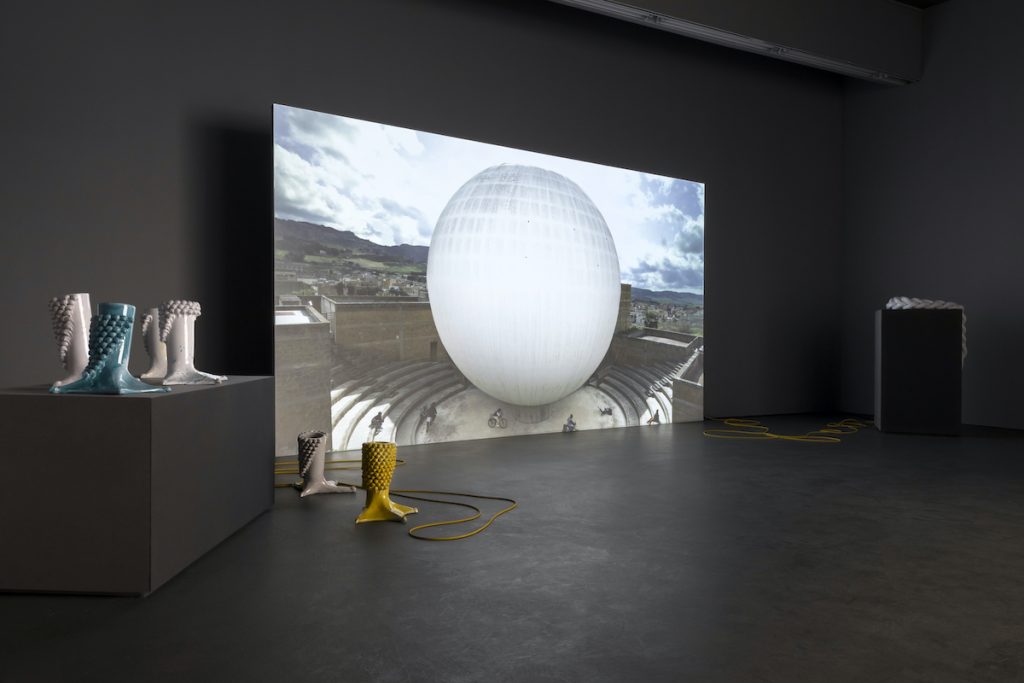
Elisa Giardina Papa, “U Scantu”: A Disorderly Tale, 2022.
Video and ceramic installation.
Courtesy the artist and Temple Bar Gallery + Studios. Photo: Kate-Bowe O’Brien
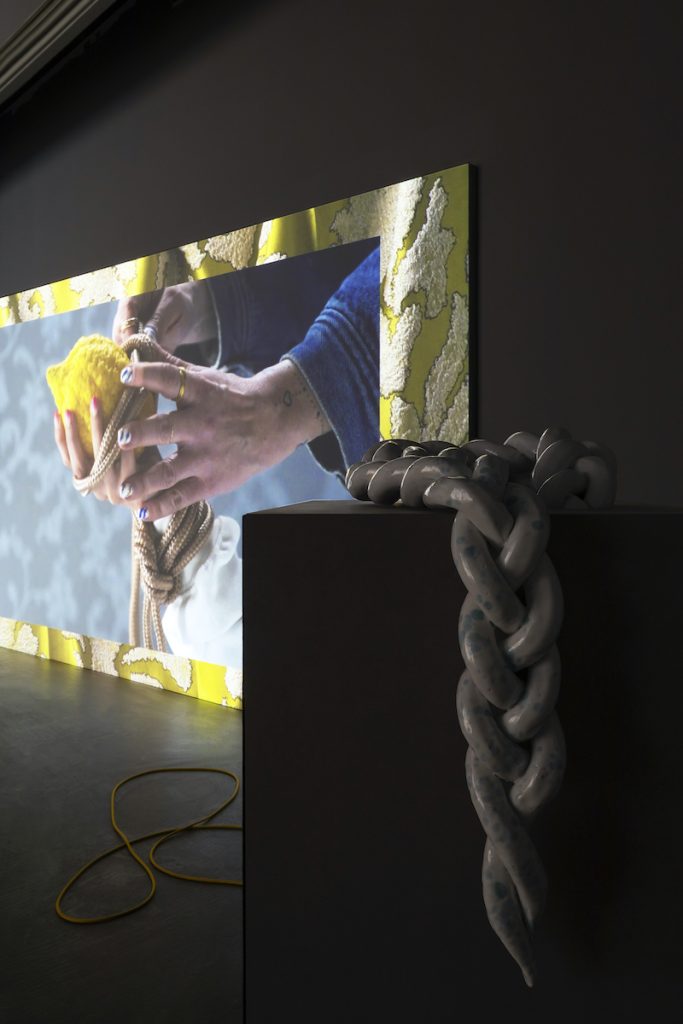
Elisa Giardina Papa, “U Scantu”: A Disorderly Tale, 2022.
Video and ceramic installation.
Courtesy the artist and Temple Bar Gallery + Studios. Photo: Kate-Bowe O’Brien
Giardina Papa uses these folkloric characters to explore the idea of being outside categories, without definition in terms of either gender or species. What is the potency or potential of the between-state? As Douglas says, ‘All margins are dangerous. If they are pulled this way or that the shape of fundamental experience is altered. Any structure of ideas is vulnerable at its margins’2. The donne as depicted in ‘U Scantu’ are what Giardina Papa describes as ‘tuners’ – young women dressed in contemporary urban clothing, riding bikes outfitted with heavy bass speakers through the public sculpture park Gibellina Nuova. They roam as a pack through hulking concrete structures, blaring music. They are ‘outsiders’, a threat to order. They have claimed public space, they are insubordinate, they are defiant.
Women suspected of being donne di fora in the sixteenth and seventeenth centuries were the subject of inquisitions and often criminalised. This was a period of witch trials throughout Europe, waves of hysteria driven by fear of female power, or perhaps fear of the uncategorisable – women who were unmarried, had no children, who knew plant medicine and the secrets of the forest, a place symbolic of shadowy unknowns and of the margins.
As part of ‘U Scantu’, ceramic sculptures of webbed goose feet and braided snakes flank the screen on which the film plays, suggesting the bleeding of animal parts into the human bodies within the frame.
Elsewhere in the gallery, Léann Herlihy’s With Everything We’ve Got! (2023) shows the body un-gridded, in freefall, dislocated from the binaries of up and down. In the atrium, a neon-green floor vinyl of an asterisk, a ‘gender star’, breaks a straight metal line embedded in the floor into multiple strands of possibility. Herlihy performed on the star as part of the extended programme of the exhibition, enacting falling over and over – falling through cracks, falling through social codes.
In the main gallery space, pieces of gym kit lie scattered, like parts of a body disassembled. A lone neon-green sock edges around a corner; a foam roller nestles in the armhole of a gym bib, like a truncated arm itself; a pair of white trainers are poised on starting blocks in the window. It’s as though the body has been taken apart to allow for the reshuffling of its coordinates on the x and y axes of gender normativity.
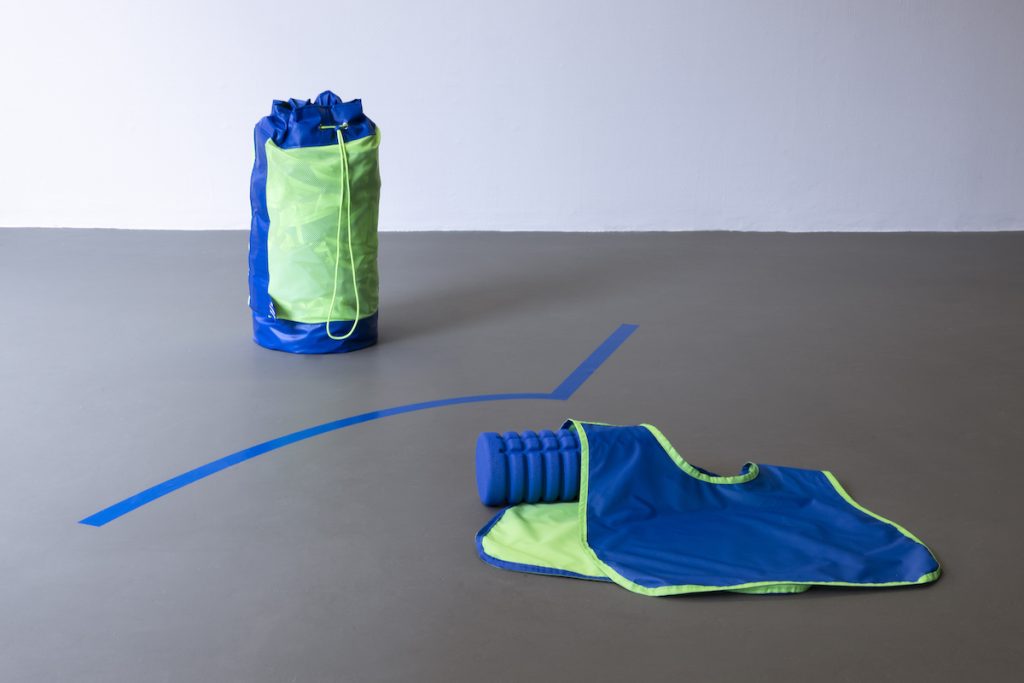
Léann Herlihy, With Everything We’ve Got! [XXS-XXXL], (detail) 2023.
32 reversible training bibs, gear bag, runners, socks, foam, digital embroidery, floor vinyl. Dimensions variable.
Courtesy the artist and Temple Bar Gallery + Studios. Photo: Kate-Bowe O’Brien

Léann Herlihy, With Everything We’ve Got! [self-description as self-determination], 2023
Text, window vinyl
Courtesy the artist and Temple Bar Gallery + Studios. Photo: Kate-Bowe O’Brien
A poster image on the outside of the gallery shows Herlihy wearing the gym gear seen inside, falling backwards at an impossible angle against a gridded background. Their body seems to float and fall simultaneously. This image is described in a window vinyl text at the front of the gallery, a piece of writing that stylistically takes inspiration from alt text image description.
The usual purpose of alt text is to offer another point of access to imagery, though there is perhaps more poetry in Herlihy’s alt text than you might usually find: it begins ‘With a misaligned equilibrium …’ and talks of the legs ‘drifting upwards’ while the whole body is ‘backwardly tilting’, emphasising the off-kilter, out-of-alignment nature of the body in the image.
Herlihy’s bodies are disassembled or mis/realigned, while Giardina Papa’s are porous and outside categories. The two bodies of work speak to each other across the exhibition. The third body of work within Reflex Blue, a combination of esoteric sculptural installation and wall images by Lyndon Barrois Jr., does not participate as easily in the conversation. In the centre of the gallery, a work titled Silent Partner(s) (2022) – an assemblage of a wooden valet stand, a blue French work jacket studded with donkey badges and other pins, and a white conservator glove holding a playing card – suggests a ghostly, playful figure. Wall images reference French filmmaker Robert Bresson and fifteenth-century Dutch painter Gerard David. SinnerMan (2022) presents the manual for a Magicolor printer tacked to the wall alongside laser prints of images depicting art conservation, while two other works, Universal International (Black & White Set #1) and Universal International (Color Set #1) (both 2022) comprise laser prints of film stills.

Lyndon Barrois Jr., Silent Partner(s) (detail), 2023.
Wood valet stand, vintage French work coat, assorted brass, copper, pewter pins and badges, mannequin hand, conservator glove, copper playing card, jute cord.
Courtesy the artist and Temple Bar Gallery + Studios. Photo: Kate-Bowe O’Brien
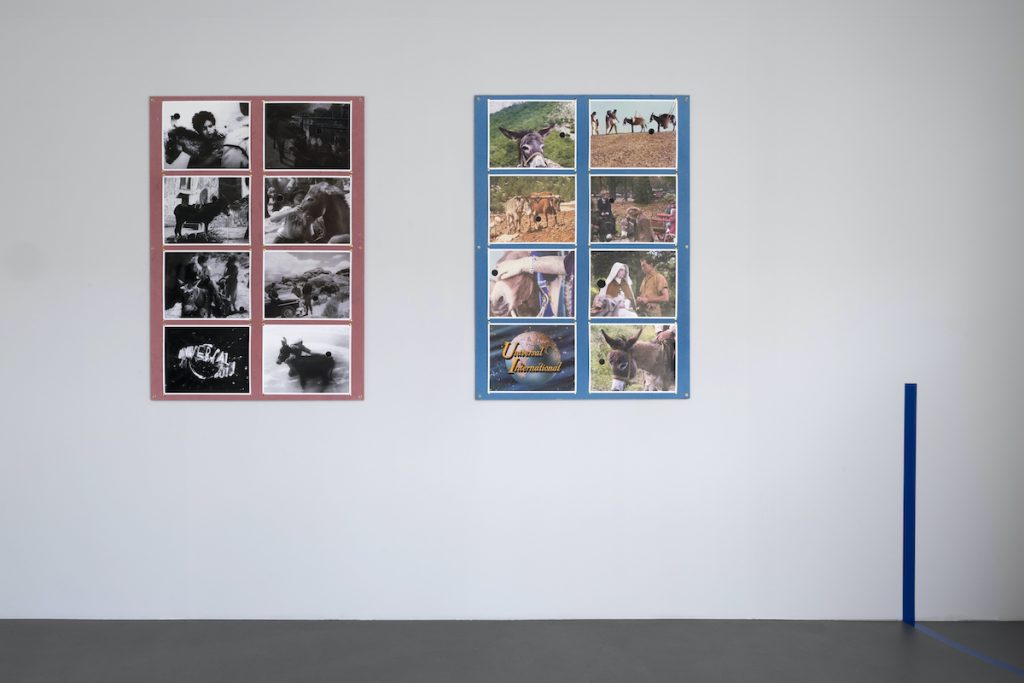
Lyndon Barrois Jr., Elisa Giardina Papa, Léann Herlihy, Reflex Blue, Temple Bar Gallery + Studios, 2023.
Courtesy the artists and Temple Bar Gallery + Studios. Photo: Kate-Bowe O’Brien
Described as being interested in ‘the sleight-of-hand that relates the cinematic world with that of an artwork conservator’, the vocabulary of these pieces feels at odds with the democratic ethos and embodied approach of Giardina Papa and Herlihy. Barrois Jr.’s work appeals to the intellect, requesting a certain knowledge of cinema (Bresson’s 1966 film Au hasard Balthazar is referenced heavily throughout), art history, and practices of art conservation. Giardina Papa and Herlihy’s works appeal to a more universal, bodily experience.
It’s interesting to reflect on the ‘tuners’ (social outsiders) reclamation of public space in ‘U Scantu’ in relation to the role of the public art gallery, one of the few freely accessible spaces remaining in civic life, and to ask how different artworks function in these spaces. Do they offer multiple access points to visitors? Or are they self-referential, preoccupied with the language of the art world itself?
Rachel Donnelly is a writer and gardener based in West Cork.
Notes
1Mary Douglas, Purity and Danger: An Analysis of Concepts of Pollution and Taboo (1966; repr. London:Routledge Classics, 2002), 150.
2 Douglas, 50.
Image Notes
Léann Herlihy, With Everything We’ve Got! [XXS – XXXL] (2023)
Image description: an installation image of a bright blue and neon green training bib bag and a reversible training bib thrown on a grey concrete floor. Between the bag and the bib, is a thick deep blue hook-like line which has been vinyled on the floor. The bib is turned in a way that the outside of the bib is bright blue with neon green trim and the inside is neon green with bright blue trim. A blue foam muscle roller lays inside the bib where the shoulders would be. The foam roller is modular in texture with lots of nodules to press into the tiny crevices of muscles.
Léann Herlihy, With Everything We’ve Got! [self-description as self-determination] (2023)
Image description: a large double window pictured from street-view. Text is vinyled across the two window panes in Suisse font and a vibrant Brilliant Blue colour. On the left window, the bigger paragraph begins half-way down the pane and reads: With a misaligned equilibrium, their legs drift upwards, hands draw inwards and shoulders drop downwards. They wear sports apparel; a matching set of blue running shorts and a training bib with neon green trim. Backwardly tilting, their exposed limbs contrast against an assemblage of blue textured grid-like surfaces of fibreglass, brick and foam. Their upper spine curves slightly upwards, inches above a solid off-white horizontal line. On the right window, a single sentence floats three-quarters down the window pane and reads: Their body is floating in a reversed orientation.
Special thanks to Áine O’Hara for accessibilty consultation, and Tom Roseingrave for editorial assistance.


